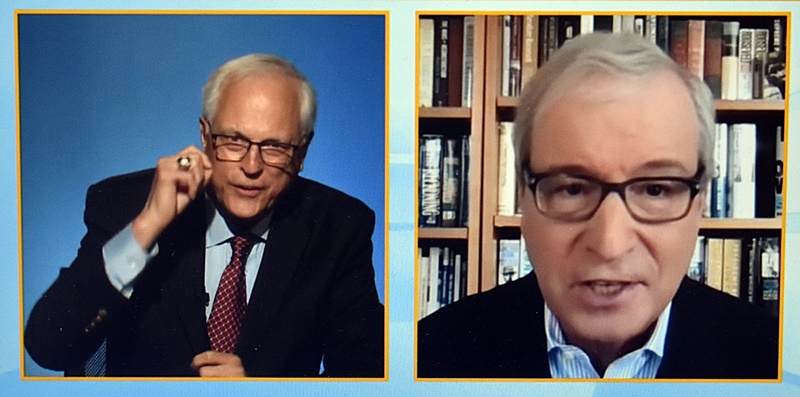Artistic haven in early 70s L.A. changed American culture
On a fateful drive home from a political fundraiser at Norman Lear’s house, Ronald Brownstein contemplated the famed producer’s groundbreaking television series "All in the Family," he recalled at a May 20 National Press Club Virtual Book Event. Other Lear series followed: "Maude," "The Jeffersons," and "Sanford and Son," among others.
Brownstein, a two-time finalist for the Pulitzer Prize, a senior editor at the Atlantic, and a senior political analyst for CNN, realized that the early seventies also saw the release of trailblazing films such as "Chinatown," "The Godfather," "The Graduate" and "Little Big Man." Additionally, Linda Ronstadt, the Eagles, Jackson Browne, Joni Mitchell and many other musicians released career-defining albums.
It occurred to Brownstein that the early 1970s was a golden age of creative talent equal to 1920s Paris, with Los Angeles the mecca, peaking in 1974. He wanted to understand how so many talented people came to be operating in the same place and time.

The result of that drive home was his new book, "Rock Me on the Water: 1974 -- The Year Los Angeles Transformed Movies, Music, Television, and Politics." Brownstein said he chose the Jackson Browne song as the title because it “conveys the openness, the sunniness of Los Angeles. It sounds like driving down the Santa Monica freeway in a convertible with a surfboard.”
Brownstein pointed out that the 1960s was an era convulsed with change. Each night, Walter Cronkite would chronicle the grim truths of racism and war, and for the next several hours, television would try to erase it from viewers’ minds. The networks produced “unobjectionable” shows such as :"Petticoat Junction," "Gomer Pyle" and "The Beverly Hillbillies," feel-good comedies shockingly untethered from reality and America’s growing social consciousness.
Movie studios followed the networks’ suit with unobjectionable films such as "Mary Poppins" and "The Sound of Music." Music, however, had a different trajectory, as it was by its very nature created by and for a younger audience deeply involved with cultural change. Overall, however, given the fact that by the late sixties some 50% of the U.S. population was under 25, there was a growing disconnect between what audiences wanted and the pablum they were getting.
As for the place where this golden age flourished, Los Angeles—which had been deeply conservative in the 1950s and 1960s — elected a progressive Black mayor, Tom Bradley, in 1973. Artists were ditching New York, crime-ridden and tottering on the brink of bankruptcy, and making their way to the comparative garden of L.A., where prices were low, crime was less, and the weather was infinitely better. It was a city poised in transition, still retaining some of its frontier past, with numerous stores selling cowboy boots.
'All in the Family': 'A rock through the screen'
The January 1971 debut of Norman Lear’s "All in the Family" — an edgy comedy about a blue-collar family struggling with social change and a lead character who was a sexist and racist bigot — struck a chord with American viewers hungry for relevant content asking tough questions.
“It came at you like a rock through the screen,” Brownstein said. “It was visceral.”
The series’ tremendous popularity set the stage for a revolution in television and film. The movie "Chinatown," for example, was a metaphor for the corruption of Watergate.
New television series offered the first inclusion of traditionally marginalized groups as main characters. "Good Times" and "Sanford and Son" examined the experiences of Black families. The "Mary Tyler Moore Show" chronicled the life of a single career woman. The lead character of :"Chico and the Man" was Hispanic. Still, Brownstein pointed out, it was mostly White men who wrote, directed, and produced these shows.
The release of the blockbuster film "Jaws" in 1975 took a huge bite out of the brief L.A. golden age of soul-searching creativity.
“This was a return to a forties style of traditional Hollywood virtues,” Brownstein said, “with heroes to cheer, villains to hiss at, excitement and adventure, but without the social and political commentary.”
Intersection of politics, culture
The book also examines how culture and politics intersect.
Culture, Brownstein discovered, changes much more rapidly than politics, as voters are often older and whiter than those involved in artistic shifts. In fact, culture and politics often move in opposite directions.
“It is striking that these ideas from the sixties that I write about cemented themselves, triumphed, in popular culture, as Nixon was twice winning national election by an electorate uneasy about the changes,” Brownstein said. “There may be times when you can mobilize a winning coalition by promising to stop the changes reflected in pop culture.”
The 2016 presidential election had certain similarities to those of 1968 and 1972, Brownstein said.
“Trump showed there is a substantial coalition you can mobilize to stop the cultural and above all demographic change that is remaking America,” he said. “If you consume the pop culture that rivets the younger generations, you have a better idea of the vision that is going to prevail in 10 to 15 years.”
Because, at the end of the day, “What you can’t actually do is stop the change."
